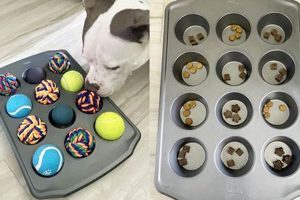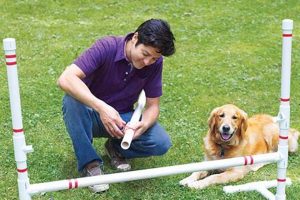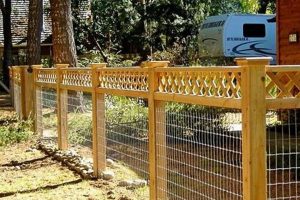A structure constructed from reclaimed wooden shipping platforms, modified to serve as a comfortable resting place for canines, is a common project among pet owners. Such a project repurposes discarded materials and transforms them into a functional and customized pet accessory. For example, a pet owner may disassemble a pallet, sand the wood, and reassemble it into a bed frame suitable for holding a dog bed cushion.
Creating such an item offers several advantages, including cost savings through the use of free or inexpensive materials. It also promotes environmentally conscious practices by reducing waste. Historically, resourceful individuals have repurposed discarded items for practical use, and this application extends that tradition to pet care.
The subsequent sections will detail the processes involved in selecting appropriate materials, preparing the pallet, constructing the bed frame, and adding finishing touches to ensure a safe and appealing outcome for the canine companion.
Essential Considerations for Pallet Dog Bed Construction
The successful creation of a safe and functional canine resting space from reclaimed wooden platforms requires careful planning and execution. The following points outline key considerations for optimal results.
Tip 1: Material Selection: Prioritize pallets designated as heat-treated (HT) rather than chemically treated, indicated by the IPPC stamp. Chemically treated pallets may pose a health risk to the animal.
Tip 2: Structural Integrity: Thoroughly inspect the pallet for damage such as splinters, protruding nails, or weakened boards. Replace or reinforce any compromised sections to ensure structural stability.
Tip 3: Surface Preparation: Sand all surfaces meticulously to eliminate sharp edges and splinters that could injure the animal. Multiple sanding grits may be necessary to achieve a smooth finish.
Tip 4: Size and Dimensions: Measure the dog’s dimensions (length and width) when resting to determine appropriate bed size. Allow adequate space for comfortable movement and stretching.
Tip 5: Joint Reinforcement: Utilize wood glue and screws to reinforce joints and connections. This increases the bed’s overall durability and prevents separation under the animal’s weight.
Tip 6: Finishing and Sealing: Apply a non-toxic sealant or paint to protect the wood from moisture and facilitate cleaning. Ensure the chosen finish is pet-safe and fully cured before use.
Tip 7: Cushion Integration: Select a cushion or mattress that fits snugly within the pallet frame. A well-fitting cushion enhances comfort and prevents the animal from slipping between the frame and cushion.
Adhering to these guidelines will contribute to the development of a safe, durable, and aesthetically pleasing canine bed from repurposed pallet materials, offering a comfortable resting place for the animal while promoting sustainable practices.
The final section will discuss advanced customization options and aesthetic enhancements that can further personalize the pallet structure.
1. Pallet Wood Selection
The selection of appropriate pallet wood is paramount to the safety, durability, and overall success of any canine bed constructed from reclaimed materials. The wood’s origin, treatment, and condition directly impact the finished product’s suitability for prolonged animal contact.
- Heat Treatment vs. Chemical Treatment
Pallets are often treated to prevent pest infestations and wood rot. Heat treatment (HT), indicated by an “HT” stamp, is a safe method. Chemical treatments, however, may involve the use of methyl bromide or other potentially harmful substances. Using chemically treated pallets for a pet bed exposes the animal to prolonged contact with these chemicals, posing a potential health risk. Therefore, only heat-treated pallets should be considered.
- Wood Species
Pallets are constructed from various wood species, ranging from softwoods like pine to hardwoods like oak. Hardwoods offer greater durability and resistance to wear and tear, making them a better choice for a canine bed that will withstand daily use. Softwoods, while easier to work with, may be more prone to splintering and damage, potentially compromising the pet’s safety and the bed’s longevity.
- Condition and Integrity
The physical condition of the pallet wood is a critical factor. Pallets with significant damage, such as cracks, splits, or signs of rot, should be avoided. These defects compromise the structural integrity of the bed, making it unsafe for the animal. Furthermore, pallets with protruding nails, staples, or splinters pose an immediate hazard and require extensive repair or should be discarded.
- Moisture Content
Pallet wood that has been exposed to excessive moisture can be prone to mold growth and warping. Mold can cause allergic reactions in sensitive animals. Warping will lead to structural instabilities. It is vital that wood must be properly dried and stable before being used in bed construction.
In conclusion, meticulous pallet wood selection is not merely an aesthetic consideration but a crucial safety measure. Prioritizing heat-treated, structurally sound hardwoods ensures a safe, durable, and comfortable resting space for the canine companion. Failure to address these aspects can lead to health hazards and a compromised final product, negating the benefits of repurposing materials.
2. Structural Integrity
Structural integrity is paramount in the construction of a canine bed utilizing repurposed wooden platforms. The fundamental purpose of the bedto provide a safe and stable resting placeis directly dependent upon the soundness of its construction. Compromised structural integrity can lead to a collapse of the bed frame, potentially causing injury to the animal. For example, a poorly constructed bed with inadequate joint support may fail under the dog’s weight, resulting in splinters, scrapes, or even more severe injuries. The choice of materials, fastening methods, and overall design contribute directly to the bed’s ability to withstand the stresses of regular use.
The implications of neglecting structural integrity extend beyond immediate physical harm. A bed with compromised structural integrity is also likely to have a shortened lifespan, requiring frequent repairs or eventual replacement. The use of insufficient fasteners, such as nails rather than screws, or the failure to properly reinforce joints are common errors that diminish the bed’s longevity. Furthermore, a wobbly or unstable structure can cause anxiety or discomfort for the animal, making it unwilling to use the bed, thereby negating the entire purpose of the project. The consideration of weight distribution and load-bearing capacity are thus essential elements of the design phase.
In conclusion, structural integrity is not merely a desirable attribute of a reclaimed wood canine bed but a critical necessity. Attention to material selection, construction techniques, and weight-bearing capacity directly impacts the safety, durability, and ultimately, the functionality of the finished product. Neglecting these considerations can lead to potential injury, reduced product lifespan, and a dissatisfied canine companion. A structurally sound frame provides a stable, lasting, and safe sanctuary, enhancing the animal’s well-being.
3. Safety Considerations
The construction of canine resting spaces from reclaimed wooden platforms necessitates a rigorous evaluation of potential safety hazards. These considerations encompass material selection, construction methodologies, and the incorporation of design features to mitigate risks to the animal.
- Splinter Removal and Surface Smoothing
Reclaimed pallets often exhibit splintered surfaces and sharp edges, posing a significant risk of lacerations and infections to the canine. Thorough sanding and the application of non-toxic sealants are imperative to create a smooth, safe surface for contact. Failure to adequately address these imperfections can result in recurring injuries and discomfort for the animal. An example of this is when a splinter becomes embedded in the dog’s skin, which can cause serious issues if it becomes infected.
- Fastener Security and Protrusion Prevention
The presence of protruding nails, screws, or staples constitutes a critical safety concern. These fasteners can cause puncture wounds and lacerations if not properly countersunk and secured. Regular inspection and maintenance are necessary to ensure that all fasteners remain flush with the wood surface. It would also be vital to remove the protruding nails or cut it down as to not harm the pet.
- Material Toxicity and Chemical Exposure
Some pallets may have been treated with chemical preservatives or pesticides that are harmful to animals. Selecting heat-treated (HT) pallets and avoiding those with unknown or suspicious markings is crucial to prevent chemical exposure. Additionally, any paints, stains, or sealants used in the construction process must be non-toxic and pet-safe. A pet may also be very sensitive to these toxins, which could result in a trip to the vet.
- Structural Stability and Weight Capacity
The bed must be designed and constructed to withstand the animal’s weight and activity without collapsing or developing structural weaknesses. Inadequate joint support or the use of substandard materials can lead to structural failure, potentially resulting in injury. Reinforcing joints with glue and screws, and selecting appropriately sized pallets for the animal’s weight are essential safety measures. One instance is when a large dog uses a small bed, which causes the bed to break or fall apart.
Integrating these safety considerations into every stage of the design and construction of a canine bed from repurposed pallets is paramount. A proactive approach to hazard mitigation ensures the creation of a safe, comfortable, and durable resting space for the animal, aligning with the responsible repurposing of materials for pet care.
4. Size Appropriateness
The relationship between size appropriateness and a canine resting structure derived from reclaimed wooden platforms is a critical determinant of its functionality and the animal’s well-being. The dimensions of the bed must correlate directly with the dog’s physical size to ensure adequate space for comfortable resting, stretching, and movement. A bed that is too small can restrict the animal’s ability to assume natural sleeping positions, leading to discomfort, restlessness, and potentially, musculoskeletal issues. Conversely, a bed that is excessively large may fail to provide the animal with a sense of security and containment. For instance, a small breed dog, such as a Chihuahua, may feel vulnerable in a bed designed for a large breed like a Great Dane.
The practical implications of this understanding extend to the design and construction phases. Before disassembling and reassembling the pallet, precise measurements of the dog are required. These measurements should encompass the dog’s length when fully stretched out and its width when curled up in a typical sleeping posture. An additional allowance of several inches should be incorporated to accommodate movement and prevent the animal from feeling cramped. The internal dimensions of the completed bed frame should then be aligned with these calculated values. Adjustments to the pallet structure, such as adding or removing boards, may be necessary to achieve the desired size. The selection of a correctly sized cushion or mattress further contributes to the overall comfort and functionality of the resting space. The effects of an incorrect size can lead to the avoidance of the canine using this resting space, because they feel it is not a suitable space.
In summary, ensuring size appropriateness is an indispensable element in the creation of a canine bed from repurposed wooden platforms. A mismatch between the bed’s dimensions and the animal’s size can lead to discomfort, anxiety, and potential health problems. By prioritizing accurate measurements and adapting the design accordingly, pet owners can create a safe, comfortable, and functional resting space that promotes the animal’s well-being. The challenge lies in accurately assessing the animal’s needs and translating those needs into precise design specifications. Correct bed sizes leads to happy dog.
5. Aesthetic Customization
The integration of aesthetic customization in the construction of canine beds from reclaimed wooden platforms extends beyond mere visual enhancement. While contributing to the bed’s integration with the surrounding decor, aesthetic choices directly impact the perceived comfort and overall value of the finished product.
- Paint and Stain Selection
The selection of paint or stain influences the bed’s visual appeal and provides a protective layer against moisture and wear. However, careful consideration must be given to the chosen product’s toxicity. Only non-toxic, pet-safe paints and stains should be used to prevent potential health risks to the animal. For example, water-based acrylic paints are generally considered safer than oil-based alternatives. The color palette can be tailored to match the surrounding room or to complement the animal’s coat color.
- Fabric Integration and Cushion Design
The incorporation of fabric elements, such as a custom-sewn cushion or decorative accents, enhances the bed’s comfort and aesthetic appeal. The fabric should be durable, washable, and resistant to pet hair and odors. Consider using fabrics like canvas, denim, or outdoor-grade materials. Patterns and colors can be chosen to reflect the owner’s personal style or to create a visually stimulating environment for the animal. The size and shape of the cushion should be carefully considered to ensure a comfortable fit within the pallet frame.
- Decorative Embellishments
The addition of decorative embellishments, such as stencils, carvings, or personalized nameplates, allows for further customization and personalization. These embellishments can reflect the animal’s personality or the owner’s creative preferences. However, it is crucial to ensure that any added decorations are securely attached and do not pose a choking hazard or create sharp edges that could injure the animal. The number of added embellishments should also not impede the canine from using the bed.
- Structural Modifications for Visual Appeal
Beyond surface-level enhancements, aesthetic customization can extend to structural modifications of the pallet frame. This may involve adding decorative legs, creating a raised platform, or incorporating storage compartments beneath the bed. Such modifications not only enhance the bed’s visual appeal but also increase its functionality. However, any structural changes must be carefully planned and executed to ensure the bed’s stability and safety. The weight of the canine must be evenly distributed to avoid damage.
In conclusion, aesthetic customization represents a crucial facet of canine bed construction from reclaimed wooden platforms, balancing visual appeal with functional considerations. Thoughtful selection of materials, fabrics, and embellishments, coupled with careful attention to safety and durability, results in a personalized and functional resting space for the animal, enhancing both its comfort and its integration into the home environment. Aesthetic choice should not impede on usability.
Frequently Asked Questions
This section addresses common inquiries regarding the construction and utilization of canine beds made from repurposed pallets. The aim is to provide clear, concise information to ensure the safety, durability, and suitability of these beds.
Question 1: What are the primary safety concerns associated with using reclaimed wooden platforms for canine beds?
Potential hazards include the presence of splinters, protruding fasteners (nails, staples, screws), and chemical treatments. Thorough sanding, secure fastening, and the selection of heat-treated (HT) pallets are essential to mitigate these risks.
Question 2: How does one determine the appropriate size for a canine bed constructed from repurposed materials?
Measure the dog’s length and width in its typical sleeping position. Add several inches to each dimension to allow for movement and stretching. The internal dimensions of the bed frame should correspond to these measurements.
Question 3: What types of wood are best suited for building a durable and long-lasting canine bed?
Hardwoods such as oak or maple are preferable due to their increased resistance to wear and tear. Softwoods like pine may be used, but require additional reinforcement to prevent splintering and damage.
Question 4: Is it necessary to seal or finish a canine bed constructed from reclaimed pallets?
Sealing or finishing the wood is recommended to protect it from moisture, facilitate cleaning, and prevent the growth of mold. Use only non-toxic, pet-safe sealants or paints.
Question 5: How can one ensure that the bed is structurally sound and capable of supporting the dog’s weight?
Reinforce joints with wood glue and screws. Select pallets of sufficient thickness to support the animal’s weight. Distribute weight evenly across the frame. Inspect regularly for signs of stress or weakening.
Question 6: What are the recommended cleaning and maintenance procedures for a pallet canine bed?
Regularly vacuum or brush the bed to remove pet hair and debris. Wipe down surfaces with a damp cloth and mild detergent. Periodically inspect for splinters, loose fasteners, or signs of damage. Replace cushions or mattresses as needed.
In summary, constructing a safe and functional canine bed from reclaimed wooden platforms requires careful attention to material selection, construction techniques, and ongoing maintenance. Prioritizing the animal’s safety and comfort is paramount.
The following section provides instructions on how to construct this type of resting space.
Concluding Remarks
The preceding analysis has elucidated critical considerations pertaining to the creation of a diy pallet dog bed. The selection of appropriate, non-toxic materials, the rigorous enforcement of structural integrity, the prioritization of safety through splinter removal and fastener security, the accurate assessment of size appropriateness, and the thoughtful application of aesthetic customization techniques collectively determine the suitability and longevity of the finished product. Neglecting any of these factors can compromise the safety and comfort of the animal, thereby undermining the purpose of the project.
The responsible repurposing of discarded wooden platforms into functional and aesthetically pleasing canine resting spaces demands a commitment to both ethical and practical considerations. While the appeal of cost savings and environmental sustainability is undeniable, the well-being of the animal must remain the paramount concern. Continued research and adherence to best practices are essential to ensure that these creations provide a safe and comfortable haven for canine companions for years to come.







